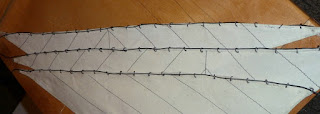However, I was a little reluctant to permanently install the masts, only to encounter a mistake or an omission and then have to try and correct my error. Also, anticipate that it's easier to work on the deck furniture without the added complication of booms and rigging in the way. Consequently, I've decided to mount the main and fore masts in a temporary "deck" (actually a short piece a 2x4) and install as many of the sails and associated rigging as possible before proceeding to other matters. Once I'm satisfied with the result, it will be a relatively simple matter (I hope) to move the completed mast assembly to the actual deck and continue with the rigging.
But before we get to that, a bit of a carry-over from my last post. Besides using the metal rings that I made for attaching the mast hoops to the sails, I also installed them on the three jibs.
After running lengths of standing rigging through the rings, the jibs are ready for installation.
Putting the jibs aside, it was time to install a few blocks for the main and fore sails. It shortly became apparent that my enthusiasm at repeatedly trying to thread the "rope" through the small holes in the blocks would rapidly wane. Fortunately, the holes were large enough that a piece of looped wire could snag the "rope" and pull it through.
This served to speed up the process considerably and this tactic will be useful throughout the build - provided the holes encountered don't get much smaller!
As it turned out, deciding to "mock up" the mast assemblies before permanently installing them was the right choice. When re-working the sails that had come with the original model, I had assumed that their dimensions were accurate to scale and neglected to double-check. This oversight came back to haunt me when I fitted the fore sail to the mast and discovered that it was too long. Trying to make it fit would result in the fore boom being positioned too close to the deck and the lifting blocks would end up touching - not exactly what I had in mind.
Several solutions involving re-sizing the sails were considered and discarded as either too time consuming, or possibly introducing other undesirable issues. The solution arrived at was to merely lengthen the fore mast by about an inch. A length of dowel, machined and bored, did the job, and one of the bands of the fore boom yoke will conceal the joint line. While this will result in a non-scale height for the mast, it will make the final assembly much more acceptable.
With that distraction out of the way, I could get on with mounting the sails and fitting hardware. Here are is where we are now; this is the fore sail.
Repeat once more for the main sail and then it's on to the top sails.
Pictures in the next post.




























